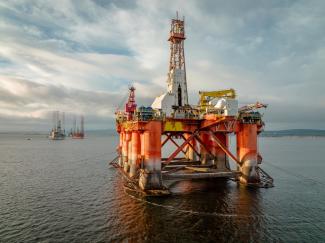Overview
Oil and gas production and exploration are critical to meeting the nation’s energy needs, creating jobs, and generating revenues.
In Fiscal Year 2024, offshore federal production reached approximately 668 million barrels of oil and 700 billion cubic feet of gas. This accounted for about 14 percent of all domestic oil production and about two percent of domestic natural gas production, respectively. As of March 2025, 472 of the 2,235 active leases in the OCS were producing oil and gas. BOEM estimates that there are undiscovered oil and gas fields totaling about 69 billion barrels of oil and 229 trillion cubic feet of gas.
For more information on BOEM’s oil and gas energy activities, visit: https://www.boem.gov/oil-gas-energy.
National OCS Oil and Gas Leasing Program
BOEM is responsible for the development of the National OCS Oil and Gas Leasing Program (National OCS Program), which establishes a five-year schedule of oil and gas lease sales in federal waters. The schedule includes the size, timing, and location of potential oil and gas leasing activity. In general, the process begins with a Request for Information and culminates with the approval of a National OCS Program, with multiple drafts and opportunities to comment in between.
For more information, visit: https://www.boem.gov/oil-gas-energy/national-program/national-ocs-oil-and-gas-leasing-program.
In Fiscal Year 2024, offshore federal production reached approximately 668 million barrels of oil and 700 billion cubic feet of gas.
Oil and Gas Responsibilities
BOEM has a number of other responsibilities relating to offshore oil and gas, including the following:
Resource Evaluation – Conduct resource evaluation through critical geologic and economic analysis to identify areas of the OCS that could be prospective for oil and gas development. Maintain a comprehensive inventory of both discovered oil and gas reserves and undiscovered technically and economically recoverable resources on the OCS.
Exploration and Development Plans – Conduct in-depth review of exploration plans and development and production plans to ensure compliance with laws, regulations, and lease terms.
Energy Economics – Conduct analyses to evaluate and implement policies relating to lease terms, bidding systems, auction designs, operating conditions, and rulemaking.
Mapping and Data – Create, maintain, and provide OCS maps and data, such as OCS blocks and administrative boundaries between adjoining coastal states. Manage, in partnership with the National Oceanic and Atmospheric Administration, the MarineCadastre.gov and Ocean Reports, an integrated marine information system providing authoritative data to meet the needs of the offshore energy and marine planning communities along with tools that can help reduce ocean use conflicts.
Risk Management – Require proper financial assurance from OCS energy lessees to guarantee that their regulatory obligations are satisfied and ensure the American taxpayer is not responsible for shouldering the liability for decommissioning existing or future facilities on the OCS.








